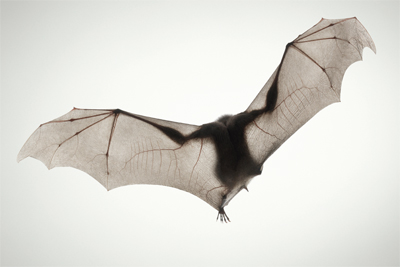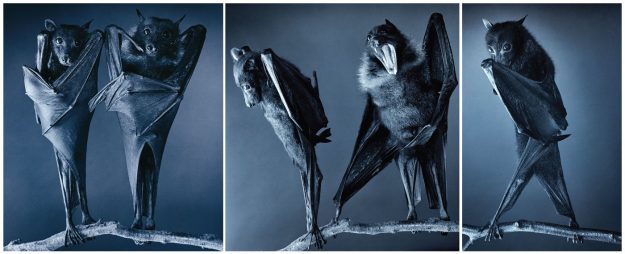Late autumn lays bare the skeleton of the garden. A low wind moans over cold ground, and darkness falls at five o’clock with the call for evening meditation. The heritage fruit trees growing at the edge of the cultivated row drop their burden of overripe apples along with any pretension of pedigree, and stand naked in the gloom of the Day of the Dead.
I welcome this haunted time of year when dark swallows light with one swift lunge. Creatures at the shank of night travel undomesticated pathways of the dark. In this somber territory the common bat is my nocturnal teacher and guide, stitching together shadow and light.

I have never been frightened of bats. Curiously, I associate this mascot of Halloween with meditation. In 1990, when our daughter was a baby, we stayed in a tiny attic room in Plum Village, France, for a monthlong meditation retreat led by Thich Nhat Hanh. Under the outside eaves of our garret, a small bat slept, hanging upside down. This bat flew out into the dark every night as we returned from meditation and then came home at daybreak to sleep just as we went out for dawn sitting. Our rhythm of meditation and rest was marked by the counterrhythms of a small brown bat.
Bats, the only warmblooded animals that fly, evolved fifty-three million years ago in the Eocene epoch and now account for more than twenty-five percent of all mammals on earth. Long-lived and fiercely dedicated to their young, more than 1,000 species of bats inhabit every continent except Antarctica. From the Greek, the name for bat is chiroptera, or “hand wing.” Birds fly with their arms and bats fly with their hands, seining the air for insects, echolocating their prey, or feeding on fruit and nectar.
Western civilization has long regarded the bat with fear and superstition. Labeled as the vampire of the night that sucks human blood, or as a flying rat that carries rabies, the bat appears throughout folklore as a companion to witches or as the devil incarnate. But these small secretive mammals who feed and travel under the cover of darkness are vulnerable because they are unknown.

Very few of the descriptions of bats are accurate. In fact, bats play an invisible role in the balance of nature, although they themselves are disproportionately endangered mammals, many species threatened with extinction by modern technology, herbicide and pesticide use, or human intervention. Yet the 20 million bats who shelter inside the Bracken Cave near San Antonio, Texas, consume 250 tons of pestiferous insects nightly, and the pollination and productivity of vanilla beans, wild peaches, avocados, bananas, figs, and mangoes depends primarily on healthy and hungry populations of bats.
In India, the flying fox bat is held sacred. A colony of such bats has roosted in a huge banyan tree for decades, pollinating acres of local figs and mangoes on their nightly flights. In Chinese, the words for “bat” and “happiness” sound identical. In ancient Chinese art, wu-fu, a well-known image, is composed of five bats circling shou, a symbol for prosperity. These bats represent the five classical joys of old China—health, wealth, long life, good luck, and abiding tranquility.
In Muir Woods National Monument in northern California, a scant three miles from our home, some sixteen species of migratory, colonial, matriarchal, or solitary bats live in the protection of the old-growth forest. In late October, two of my closest friends and colleagues were married in these woods at nightfall. As their quiet vows rose up from the well of darkness, I remembered a favorite passage from the eighth-century Chinese poem widely known as the “Sandokai”:
In the light there is darkness,
don’t take it as darkness;
in the dark there is light,
don’t see it as light.
Far overhead we heard the rustling of a cloud of invisible bats rising out of the shelter of black fire scars, filling the autumn night with ancient joy.